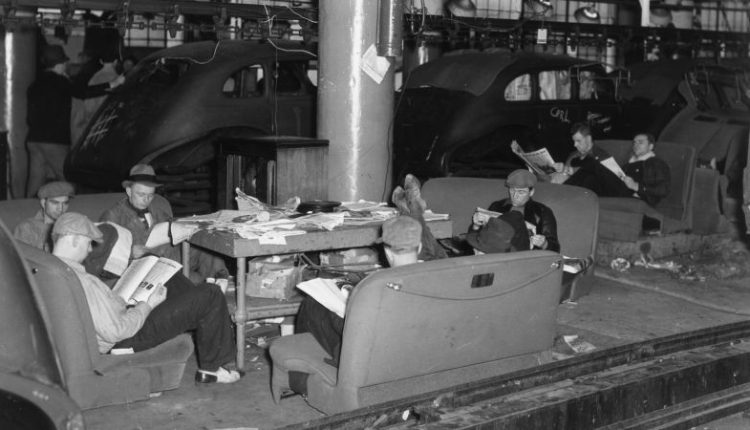During the final days of 1936, about 50 autoworkers at General Motors shut down their machines at Fisher Body Plant No. 2 in Flint, Michigan, and sat down.
The workers, members of the tiny United Automobile Workers union founded just a year prior, sought to improve brutal working conditions at mighty General Motors, the world’s largest manufacturer. They also demanded GM recognize the union as workers’ bargaining agent in negotiations.
The UAW’s sit-down strike across GM plants lasted 44 days. It is considered the most important work stoppage of the 20th century and a turning point in relations between companies and workers in America. It was a breakthrough for unions and led to a wave of labor organizing across the country.
Now, the UAW is on strike against Detroit’s Big Three — General Motors, Ford and Stellantis —for the first time. The strike comes at a critical moment for both a re-energized labor movement and an auto industry in transition as the electric vehicle era dawns.
The UAW, led by upstart president Shawn Fain, has updated its tactics. The UAW is calling its new strategy a “stand up strike,” a reference to the sit-down strike that started 87 years ago, and has launched targeted strikes at selected plants.
“Shawn Fain is drawing from the union’s long history and modernizing the UAW tradition,” said Thomas Sugrue, a historian at New York University. “The union is relying on understandings of the past, but a reinvention to respond to current conditions.”
During the 1930s, UAW workers were protesting the intense speed they were forced to work on assembly lines, the arbitrary power GM foremen had to hire and fire them, and unlivable wages. GM had disrupted workers’ attempts to form a union through spying campaigns and firings of organizers.
Sit-down strikes had been spreading in Europe at the time, and UAW workers were inspired by those efforts.
Sit-down strikes were a novel tactic and had several benefits over a traditional strike, which involved workers walking off the job, writes labor journalist Steven Greenhouse in “Beaten Down, Worked Up: The Past, Present and Future of American Labor.”
Police often attacked workers, and replacement workers could easily take their jobs while they picketed outside. By sitting down, workers stayed inside the factory and near their stations so “scabs” couldn’t take over. Management was hesitant to send in police out of fear valuable machines would be damaged.
The initial strike at Fisher Body Plant No. 2 quickly spread to other GM plants in various cities, crippling GM’s operations.
On January 11, 1937, two weeks into the strike, workers at the plant clashed with GM security and Flint police after the company cut off heat and electricity and prevented food from being delivered to workers inside. The clash left dozens injured. Michigan Gov. Frank Murphy called in the National Guard and ordered both sides to negotiate.
Forty-four days later, the two sides reached a compromise in which GM agreed to recognize the UAW as the bargaining agent for workers who wanted to join the union.
It was a watershed victory for the union.
“The workers in the other basic mass production industries,” one union leader told the New York Times, “will derive from the auto workers’ struggle the confidence and conviction that they, too, can win similar rights in their industries.”
The GM sit-down strike led to a burst in UAW membership.
Its membership surged from 88,000 in February 1937 to 400,000 by October. By 1941, it had jumped to 649,000 members, according to Greenhouse.
The sit-down strike also prompted unionization and a wave of strikes in other industries.
“Sitting down has replaced baseball as America’s pastime,” Time Magazine said in 1937.
Stand-up strike
The UAW’s victory helped lead to unionization at Chrysler in 1939 and Ford in 1941.
Detroit’s unionized jobs with rising wages and company-provided benefits set a standard for other manufacturing jobs and helped lead to the formation of the middle class during the mid-20th century.
“Auto industry jobs in the history of US have been an important bedrock of the emergence of the middle class,” said Joseph McCartin, a labor historian at Georgetown University.
But non-unionized foreign and domestic competition has undercut the US auto industry and eroded UAW jobs and benefits in recent years.
Unions across America have also declined, peaking in 1945 at 33.4% of the workforce. Last year, 10.1% of workers belonged to unions.
Current UAW leadership, led by president Fain, is seeking to recapture the energy from the sit-down strike against GM during the 1930s.
The UAW dubbed its targeted strike of three plants as a “stand up strike,” which it called a strategic “new approach” to walking off the job.
“The Stand Up Strike is our generation’s answer to the movement that built our union, the Sit-Down Strikes of 1937,” the UAW said in a statement. “Then as now, our industry is rapidly changing and workers are being left behind.”
The negotiation between UAW and Detroit’s Big Three will have a long-term impact on both the auto industry and manufacturing jobs, McCartin said.
“The question here is whether manufacturing jobs, as they grow, will function as middle-class jobs.”
Read the full article here

